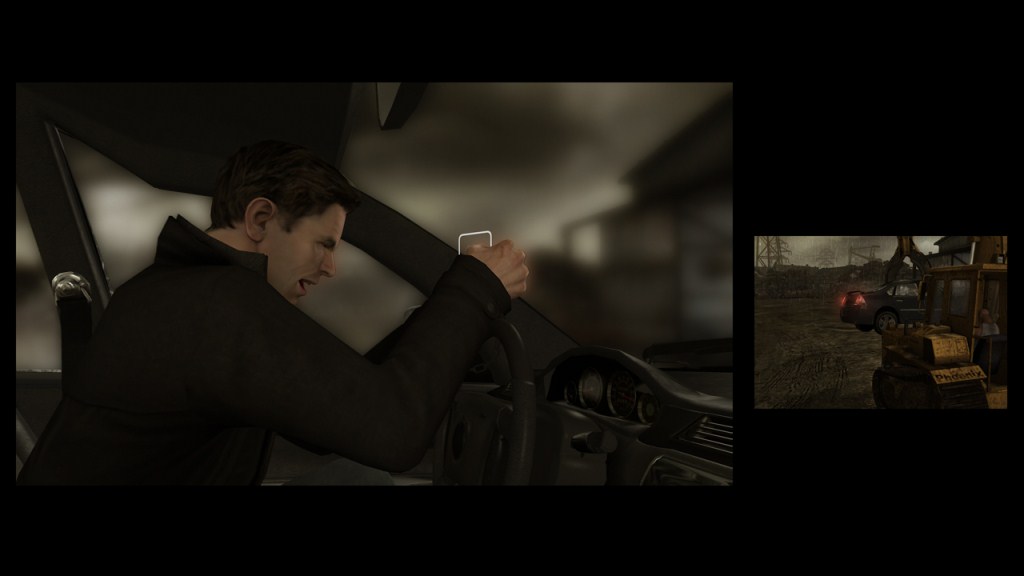
I remember my first experience with a QTE (Quick-Time Event). I was playing Resident Evil 4 and had finally reached a break in the action. I sat back and believed that I could relax and enjoy the playing cutscene when suddenly a button, for almost no reason, flashed in front of the screen and before I could react, I was killed and given a giant game over screen. I got ticked, stopped playing, and began to resent every game since that involved QTE in any way, shape, or form. That was until last Tuesday, when Heavy Rain was released for the PlayStation 3.
To say it has QTE is doing Heavy Rain a disservice in a way. The way that these real-time action prompts, what I prefer to call them, are displayed is far different and superior to anything any game has done before. And because of the way that these actions and events are controlled and presented, I believe that Heavy Rain is a historic turning point in not just QTE, but quite possibly videogames themselves.
In most games that have used QTE systems, you are brought into a cutscene after a long sequence of tense action. You are watching the cutscene, punch by punch, kick by kick, until all of a sudden you are asked to press a button in order to prevent a killing blow, or something of that nature. The button will flash at the bottom or middle of the screen and if you fail, it’s game over and you have to start again. This is far from the case in Heavy Rain.
The controls of Heavy Rain make you feel like you are literally controlling the character’s movements. L1 will let you move your left foot when prompted, the controller as a whole can act as a steering wheel, the analog stick controls your body as it dodges attacks, etc. It immediately gives you this sensible feel to the real-time actions that really immerses a player and far exceeds the "press this random button right now" QTE systems of other games.
In these sequences, each button prompt also coincides with what exactly you are responding or reacting with. If you are about to be punched in the face, the button will show up over the enemy’s right fist. This acts just like how your body would tell you to react in real life. If you are in the middle of a fight, your brain is going to predict the punch coming by seeing the fist, alerting you to react, and then leaving it up to your reflexes to react in time. This extremely realistic method only adds to that intense level of immersion found in Heavy Rain that is completely absent in other games.
There is also the fact that even though the characters you control are at risk of dying during these moments, the game continues to truck on as if it was part of the narrative all along. There’s no "game over" screen that forces you to do it all over again and feel like a complete failure. The game simply branches off in different directions, creating different experiences almost every time you play, and can be a great topic of conversation with friends. It does what so many FMV (full-motion video) games tried to do in the ’90s on the Sega CD and failed, which is to recreate the feel of reading "choose your own adventure" books.
I remember exactly when it hit me. I was playing as Scott Shelby for the first time and he got into a fight with one of main character’s clients in an attempt to defend her. The way everything was presented, the way it all flowed, I found myself far more engaged than I ever had been by a QTE system. The feeling was amplified during the freeway sequence with Ethan Mars. I found myself jerking the controller left and right in response to the real-time actions as if I was literally gripping the wheel of this car. I was jerking the controller up and down with force to deliver headbutts and spear tackles. I even bobbed my head back and forth to avoid punches. I was completely sucked in. It was then that I realized, Heavy Rain was giving me an experience that no game had ever given me before. Videogames have been revolutionized.
This is not to say that games will now all include these kinds of sequences, or that all games will become just like Heavy Rain. But Heavy Rain has changed my opinion on just how a game can be played. Many critics out there seem to agree and praise the game for this as well.
It will be interesting to see what is to come in the aftermath of this achievement attained by Quantric Dream. Developers that look to use a QTE or real-time action system in their games can very well integrate Heavy Rain‘s method into them in some way or form that can make them that much more immersive than they already were. Perhaps Heavy Rain is the first of a new genre of videogames, which I personally would like to coin as RTA (Real-Time Action). Whatever happens, I await it eagerly.
As for anyone who may feel that Heavy Rain does not have the right to be called revolutionary because the game itself is not perfect, which it is not thanks to lackluster voice acting and some animation hiccups, consider this: Throughout history itself, revolutions have never been perfect. What made them revolutions was that they challenged the norm with something completely innovative and different. And in turn, they completely changed the masses’ notions of what the norm is and what the norm can be. When you put it in that context, Heavy Rain is without-a-doubt a revolution for QTE and the videogame industry itself.

















